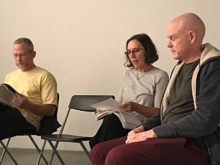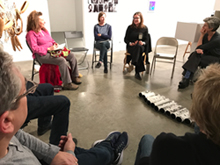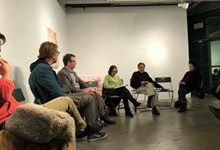From 2010-2020 I organized and curated on a volunteer basis a free and open to the public series of
open forum, roundtable Art Discussion at Eastside International (ESXLA) in Downtown Los Angeles. The
discussions were typically held on a six-week schedule. I invited a guest initiator such as an artist, critic,
curator, or art dealer to choose a topic of interest and introduce it briefly to those in attendance. Then,
the floor opened for discussion for the remainder of the evening and all became active participants in
the conversation. Each meeting was an evening of conversation where those interested in art and art-
world issues regularly met to analyze and discuss them. Also, mindful of gender equity, I had made it a
priority to choose alternating male and female guests from month to month with few exceptions. Many
thanks go to the generosity of the guest contributors for making these discussions possible and to
Eastside International for its support.
Here is a list of initiators and their discussion topics:
2020 February 20, Dr. Jillith Moniz, Curator, "Why Do Artists Revere the Market?"
2019 December 5, Celebrating 10 Years, Group Initiation, 4 topics chosen by the audience.
2019 November 7, Rebecca Morales, Artist, "Holding One's (internal) Practice Through Diversions of Necessity and Chaos."
2019 September 4, Mat Gleason, Art Critic, Curator, Gallerist, "Working Class Vs. Leisure Class: Where do Artists Come From and Where are They Going?"
2019 June 20, Siobhan McClure, Artist, "Craftsmanship as an Albatross - Is Skill Seen as the Enemy of the Contemporary Artist?"
2019 May 2, Robert Gunderman, Artist and Former LA Gallerist, (ACME Gallery), "How has the expanding number of art fairs influenced gallery programming, collecting habits, and ultimately what's made in an artist's studio?"
2019 March 28, Patricia Lea Watts, Curator and Writer, "Epochal Change, What is It? What Would It Look Like? What Speculative Forms of Art Making are Needed to Get There?"
2019 February 27, HK Zamani, Artist, "How Does Your Politics Influence Your Art?" Art provides: "the irregular, transitory, and sometimes unwanted news of how it is to be another human being." - Maggie Nelson
2019 January 24, Francesca Gabbiani, Artist, "Art and the Poetics of Non-space - the unattended urban landscape as the source of artistic vision." Sites of abandoned landscapes are often unnoticed and not remembered. What is their function in the city? Do they have one?"
2018 November 7, John Millei, Artist, “Neither Here Nor There: Painting in the Liminal Space.” John writes: “It has been several years since the last time there was a unified set of questions driving the direction of painting. Since the end of post-modernism artists have been working in what can only be described as a period of hyper- pluralism, it’s a kind of free for all of style mashups executed with reckless abandon with no signs of a unifying philosophy in site. The discussion will focus on the upsides and pitfalls to what has become a relativist approach to painting.”
2018 Tom LaDuke, Artist, “The Art of Carving a Headstone - If it is given that in one way or another we artists produce endless iterations of self portraits, then we must also conclude that everything we make is in a way a representation of our own death - a corpse. Paradoxically, it is the very act of production that makes us most alive. Is our work a paradox and, if so, can it be resolved?"

2018 Rebecca Niederlander, Artist, “Art and Service: What’s in it for me?” “Are there particular skill sets that only a creative person can bring to the issues society needs to address in order to survive? If artists can make a significant difference, then is the community engagement model the best practice method for our careers? How can we save us and the planet?”
2018 Kristina Newhouse, Curator, University Art Museum, California State University, Long Beach, “Art and Relevance" based on a book by Nina Simon titled: "The Art of Relevance," Simon writes: "Your work matters when it matters to people -- when THEY deem it relevant, not you.” “What do the London Science Museum, New World Symphony, and the National Park Service have in common? They are all fighting for relevance in an often indifferent world."
2018 Doug Harvey, Artist, Art Critic, "Can the Art World be Reformed or Should We Just Move 5 Miles to the Left and Start from Scratch?" “The Art World has been diverging exponentially from the philosophical, political, psychological and sensual concerns that made me choose to be an artist in the first place. I've been wondering if others feel as alienated as I do, and if they think the damage can be healed or if there's any way we can cut The Art World loose to follow its own doom, and start over from scratch. Or is this process already underway?”
2018 Susan Silton, Artist, "Artistic Output in a Time of Crisis - How is the current state of political and social upheaval in the country impacting art production? What are the psychological and artistic effects of living under these conditions?”


2017 Howard Fox, Curator, "The Complex Relationship between Practicing Artists and Museums" “It is a relationship destined to embody brilliant achievement among individual artists and museums who exhibit them and yet bedevil artists and curators alike who must acknowledge the institutional limitations in which they operate."
2017 David DiMichelle, Artist, “The Future of Abstract Art” “Abstract art is propelled by the urge to push toward the limit, to colonize the borderland around the opening onto nothingness, where the land has not been settled, where the new can emerge. That is part of what drives modernity: the urge to regenerate ourselves by bathing in the extreme, for better and for worse."
2017 Kristine Schomaker, Kio Griffith, Artists, Curators, "Community, Collectives and Collaboration - How artists are making it in the 21st Century” Discussion will focus on the paradigm shift that is taking place for 21st Century Artists and how artists are finding success and fulfillment.
2017 Tomory Dodge, Artist, "Painting is the Loneliest Number - the notion of painting as a primarily solitary act and how this functions in a time where technology and social media have potentially brought the idea of the public act and performance into areas where it previously hasn't been." Does painting remain one of the few modes of art making that is still intimately connected to some notion of craft and the artist's hand? Does this make painting an outlier at a time when much art production is centered around fabricators and hired hands if it even takes physical form at all?
2017 Monique Prieto, Artist, "Carry-on Painting” Monique writes, “Using 'carry-on' as a metaphor for painting in terms of moving painting along and its art historical baggage, we will approach it with questions like: Are you a light packer or do you feel best prepared to travel with a set of luggage ready for contingencies? How much of art history do we bring along? What can we leave behind? Would we want to pare down to a single carry-on? Deciding what to leave behind and what feels absolutely necessary requires examining our expectations.”
2017 Dan McCleary, Artist, "The Difference between Working from Life and Working from Photographs - Observed Reality vs. Photographic Reality - Can these two disciplines be reconciled?"
2017 Ingrid Calame, Artist, "What's Love Got to do with it: the Artist's Secret Longing to Bless the World” A continuation of a topic first introduced by Lynn Aldrich in 2016. Ingrid writes: “I would like to continue the discussion as a confessional: a support group for the hopelessly hopeful, the magically imaginative, and the impossibly rich in cash, thought, word or deed. Come with your story of how art did indeed bless the world.”
2016 Tim Youd, Artist, "A Painting is not a Picture, Mark Rothko, Flannery O'Connor and the Nature of Meaning." Working in different disciplines, Flannery O'Connor and Mark Rothko each came to strikingly similar notions regarding the nature of meaning. According to them it is only available through the full engagement with the work.
2016 Constance Mallinson and Marie Thibeault, Artists, "Can Painting Be An Effective Vehicle in Addressing Environmental Issues?" Thibeault will focus on the unique abilities of abstraction to address collapse, instability, and the sublime while Mallinson will present some of the historical writings of Georg Lukacs in his argument for the importance and relevance of realism.
2016 Tony de los Reyes, Artist, "How Much Content Can Color Hold?" The discussion will regard different color theories but not limited to Alber's systematic attention to color, and an introduction to the artist’s use of color regarding his Border Theory Project. A significant book inspiring this topic is "Chromophobia" by David Batchelor, which will also be discussed.
2016 Rebecca Campbell, Artist, “Arranged Marriages; Why Forcing the Brain and the Body to Work Together to Make a Painting is as Revolutionary as it is Old-Fashioned” Roland Barthes’s suggests that the value of works in modernity comes from their duplicity. In consideration of that, discussion will focus on the seam between ideas and their performance.



2015 Sandeep Mukherjee, Artist, "Painting as Verb, Painting as Noun - Painting is understood as an intersection of process and image where their difference becomes evident in the effect that the work generates. Is it a virtual space? Where is the body in this transaction? How does it mark and how is it marked? What is the direction of causality in this process?"
2015 Chris Truman, Artist, “The Relationship Between Abstract Painting and Digital Media - As the gap between the digital and analog is narrowing, how is it affecting our conception of Abstraction?" Digital technologies, screen aesthetics and increased availability of new output devices are changing the painting game once again.
2015 Lynn Aldrich, Artist, "What's Love Got to do with it: the Artist's Secret Longing to Bless the World - Is spirituality a problem in contemporary art? Can irony rescue sentimentality? What forms does mystery take in a secular age? Does beauty need to be more interesting? Does art itself bring love and grace into the world?"
2015 Cole Case, Artist, “Masters, Servants and Role Models, The Art of Copying in an Age of Nonmechanical Reproduction - What is the role of the copy in artistic dialogues? What is the job and responsibility of the copier? What is appropriation and what is plagiarism? What constitutes a master? Is there even any notion of any kind of canon anymore?"
2015 Susan Sironi, Artist, “Making a New Mark, – Is Craft an Obstacle or a Way In? - What happens when an artist uses only the technique and misses underlying content and form? Or, conversely, what happens when content is overly explored without consideration of any aesthetic?" Focus, concentration and time are worthy of a result but the consequence of relying too much on craft can be as defeating as ignoring its potential.
2015 John Mills, Artist, “The Need for or Lack Thereof of Content, in Abstraction, Painting and life as it refers to the tradition of abstract painting and its present state.” Inquiry as to what does "Content" specifically refer to in painting? Does it include the context and era in which it was painted, the persona of the artist, its response by the art community and/or can a work stand alone on its own merit?
2015 Shana Nys Dambrot, Arts Editor – LA Weekly, Art Critic, “Art and Criticism – A Love Hate Relationship” Shana Nys Dambrot initiated discussion on the current role of Art Criticism - its scope and influence. As a reflection of locating and pinpointing current painting, so too is Criticism redefining itself in a global and pluralistic art world where there is no longer a Greenbergian and Rosenbergian polemic.

2014 Keith Walsh, Artist, “An Inquiry into Art as Emergent Social Process - How do we bring our work to emerging new ideas and how do we bridge the gap in how this 'new' communication is conveyed to the community?”
2014 Samantha Fields, Artist, “The Artist as a Construct: Media Stereotypes versus Social Media Personas versus IRL” Focus will be on these different levels of identity and how artists navigate them.
2014 John Kinkead, Gallerist, “Relationship Advice – How to Develop One with a Gallery” Former owner and gallerist of Kinkead Contemporary, Culver City, CA, John Kinkead will initiate a discussion on how to develop a strong relationship with a gallery by discussing the artist's role and how to sync it with the gallery and its mission.
2014 Yvette Gellis, Artist, “Dumb Painting” Painting has gone through various periods of popularity and practice. With the advent of crapstraction or provisional painting has it now become a ‘mindless medium’?
2014 Dr. Grant Vetter, Writer, Curator, Arizona State University Art Galleries, “Is Dave Hickey Still a Genius? Air Guitar or More Hot Air? Where we are now with relation to art criticism, art schools and identity politics and the 'cult' status of Dave Hickey. Populace saint and defender of beauty, or secret agent of the status quo?”
2014 Kiki Seror, Artist, “Neither Subject nor Object – Exploring the Implications of Shock Value and the Dialectics of Transgression". Based on an essay by Julia Kristeva titled: “The Powers of Horror.”
2013 David McDonald, Artist, “How Can Painting Be Real in Relation to the Object? – Delving into the boundaries between reality and illusion in painting and sculpture with an emphasis on painting”
2013 Christy Roberts Berkowitz, Artist, “Sustainability in the Studio Is there reluctance among culture producers to see the mortality of our objects and does this reluctance lend itself to our material practice? What kind of agency are artists embedding in their objects if their processes and materials are perpetuating exploitation, both of resources and of humans and nonhumans?”
2013 Ted Svenningsen, Artist, “What’s All This About Art Being Subjective? – The Subjective and Objective in Painting Criticism"
2013 Michelle Carla Handel, Artist, “Gender Disparity in Contemporary Art – The Current State of Women in Contemporary Art as Art Makers”
2013 Jason Ramos, Artist, Curator, ESXLA Director and Curator, “To What Degree and How Do the Forces of Money and the Art Market Influence the Art World Generally?”



2012 Dominic Qualozzi, Artist, “Can There be Paintings Without Painters and Can There be Painters Without Paintings? Art-making in the age of touchscreens and virtual art reality"
2012 Constance Mallinson, Artist, Writer, Curator, “Provisional Painting” Based on an article written by New York critic Raphael Rubinstein, in "Art in America", where he reveals a painting practice that is "casual, dashed off, tentative, unfinished or self-cancelling ... looking like utter failures ... intentionally feeble and bordering on carelessness ..."
2012 John David O’Brien, Artist, Curator, "“Meticulosity” and “Provisional Painting" - Comparing opposing styles of painting and drawing." “Meticulosity” a co-curated exhibition by John O'Brien and Meg Linton, (then Curator at the Ben Maltz Gallery at Otis College of Art and Design, Los Angeles) is compared with that of "Provisional Painting," two articles written by Raphael Rubenstein in Art in America.
2012 Max Presneill, Artist, Curator, Torrance Art Museum, “Questioning Abstraction” A continuation on the parameters of current abstract painting.
2012 Robert Levine, Artist, “Demystifying the Happy/Sad Dialectic in Art and Unpacking the Dualities and Dichotomies in Art” It is the attempt to take on both sides of a given paradigm and make a "unified" work that can create a unique "disorder.” This chaotic effort is where conflict, fascination and complexity lie.
2012 Mara Lonner, Artist, “Expectation in Art - From a personal perspective what do we expect the outcome of our art production to be?”
2012 Max Presneill, Artist, Curator Torrance Art Museum, “Abstraction and What Makes it Distinctly American. How do These Forms Relate to Representation? What are the differences from earlier forms of modernism? What do they mean politically, socially and what is the context here? In what context do we read them now? What might all this mean for painting over the next few years?”
2011 Gina Stepaniuk, Artist, “New Romanticism – Painting the Landscape in the Age of Climate Change”
2011 Merion Estes, Artist, “Beauty and Contemporary Art - Women, Beauty and the Cultural Biases that Exist”
2011 Dan Callis, Artist, “Comparing Applications and Installation in Painting – 2 Shows “Howard Hodgkin” at MOCA San Diego and “Art in the Streets”, exhibition at MOCA Los Angeles. Considering one’s practice as a painter and the negotiation between the interior and exterior.”
2011 Ezrha Jean Black, Staff Writer Artillery Magazine, “Beautiful Decay – Decadence and Decay in Contemporary Art Making.” There may really be at bottom - nothing new under the sun. "Technically, every work of art comes into being in the same way as the cosmos - by means of catastrophes, which ultimately create out of the cacophony of the various instruments that symphony we call the music of the spheres.” – Kandinsky
2011 Andre Yi, Artist, “Painting and Technology – Art in the Age of the Internet and Its Impact on Arts Culture”
2010 Constance Mallinson, Artist, Writer, Curator, “Contemporary Abstraction – What accounts for the persistence of abstract painting in today’s world of diverse art productions? Why do artists continue to make it?”
